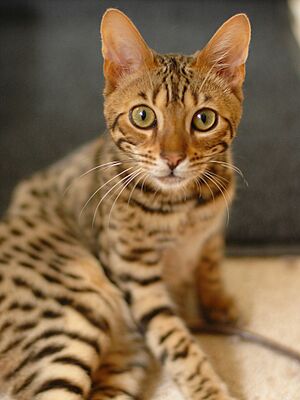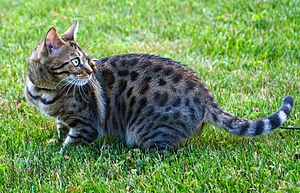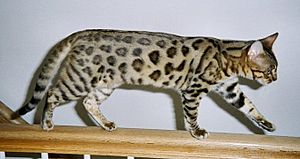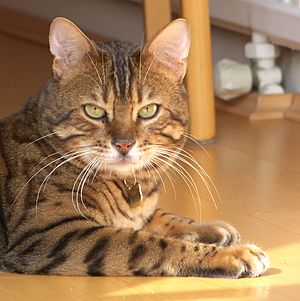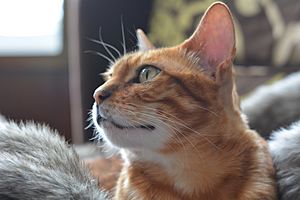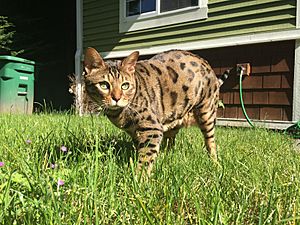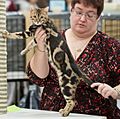Bengal cat facts for kids
Bengal cats are a special kind of house cat that is a hybrid (a mix of two different types). They were bred to be calm and not get angry easily. Most Bengal cats have spots, like a wild cat, and usually weigh between 7 and 20 pounds (about 3 to 9 kilograms).
Contents
How the Bengal Cat Breed Started
In the 1970s, a scientist named Willard Centerwall started breeding Asian Leopard Cats (ALCs) with regular house cats. He did this to study their genes because ALCs seemed to be immune to a cat disease called feline leukemia. Later, these special mixed cats were given to Jean Sudgen Mill.
Around the same time, another person named Bill Engler also wanted to mix wild cat genes with house cats. He chose the name "Bengal" for these cats. The American Cat Fanciers Association (ACFA) was the first group to officially accept the Bengal as a new breed.
Jean Mill played a big part in getting Bengals recognized as a breed by The International Cat Association (TICA) in 1983. Her goal was to make these cats fully domesticated, meaning they would be good pets, by breeding them with each other over many generations.
Other early breeders, Greg and Elizabeth Kent, also helped create the Bengal breed. They used ALCs and Egyptian Mau cats to develop their own line of Bengals. Many Bengal cats today can trace their family tree back to these early cats.
What Bengal Cats Look Like
Bengal cats have "wild-looking" markings, like big spots and rosettes (spots with a darker outline). They also often have a light or white belly, and their body shape reminds people of a small leopard. The rosetted spots are usually found on their back and sides, while other parts of their body might have stripes.
A common feature is "mascara," which are horizontal stripes next to their eyes, and stripes on their front legs. Bengal cats have fairly large eyes, which are usually bright blue or green.
Bengal cats are mostly known for two main colors: brown-spotted or snow-spotted. However, there are other colors too. Brown Bengals can have either marble patterns (swirling patterns) or spotted patterns. The spotted type can include rosetted spots. Snow Bengals also come in marble or spotted patterns, and their eyes can be blue or another color.
The International Cat Association (TICA) recognizes several Bengal colors, like brown, seal lynx point, mink, sepia, and silver. They also recognize spotted and marbled patterns for cat shows.
Bengal cats are usually larger than the average house cat. Male Bengals typically weigh between 10 to 15 pounds (4.5 to 6.8 kg), and females weigh between 8 to 12 pounds (3.6 to 5.4 kg).
Bengal Cat Personality
After a few generations of breeding, Bengal cats usually become gentle and friendly, like typical house cats. For most pet owners, it's best to get a Bengal cat that is at least four generations (F4) away from the original wild leopard cat. The first few generations (F1-F3) are often kept by breeders or by people who have special homes for them.
Bengals are known for liking water, which is unusual for cats! They also need a lot of attention to stay happy. Bengal cats love to play and have even been seen jumping over 4 feet high from the ground!
Bengal Cat Health
Like all breeds, Bengals can have some health issues. One rare genetic problem found in Bengals can cause blindness in their first year of life. Another condition called hypertrophic cardiomyopathy (HCM), which affects the heart, is seen in about 16.7% of Bengals.
Blood Type
Most Bengal cats have Type A blood. A study in the UK found that 98 out of 100 Bengal cats tested had Type A blood. This means Type A is the most common blood type for this breed.
Shedding and Grooming
Bengal cats are popular not just for their looks but also because they shed very little. Some people say Bengals are hypoallergenic, meaning they don't cause allergies. However, this isn't always true. While some people might not react to them, others can still have an allergic reaction. This is because allergies are caused by a cat's dander (tiny flakes of skin), not just how much fur they shed.
Bengals are very good at grooming themselves, so they don't need much help from you. However, vets suggest brushing them once a week. This helps to reduce shedding even more and keeps their coat healthy and shiny.
Long-haired Bengals
Some Bengal cats have longer fur, which are called semi-long-haired Bengals. These cats have appeared since the very beginning of the Bengal breeding program. This is because some of the domestic cats used to create the breed had longer fur.
Today, some purebred Bengals carry the gene for long hair. If two Bengals with this gene breed, they can have long-haired kittens. For a long time, these kittens were not considered standard Bengals and were usually spayed or neutered. However, on August 21, 2013, the New Zealand Cat Fancy (NZCF) officially recognized long-haired Bengals as a "preliminary" breed under the name Cashmere. Currently, no other major cat registries recognize them.
Cheetoh Crossbreed
The Cheetoh cat is a newer breed that is being developed by mixing two existing spotted cat breeds: the Bengal and the Ocicat. The goal is to create a third unique breed.
The United Feline Organization (UFO) first recognized Cheetohs in 2004. Since at least May 2009, The International Cat Association (TICA) has given them "experimental breed" status. This means they are still being developed and are not yet allowed to compete in cat shows.
Images for kids
See also
 In Spanish: Bengala (gato) para niños
In Spanish: Bengala (gato) para niños


